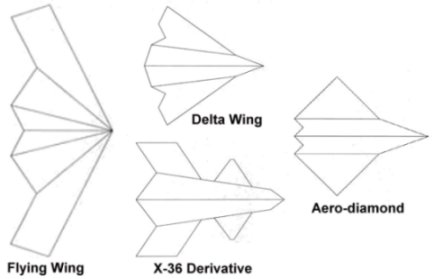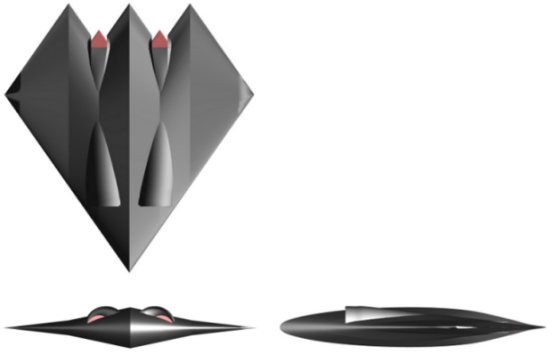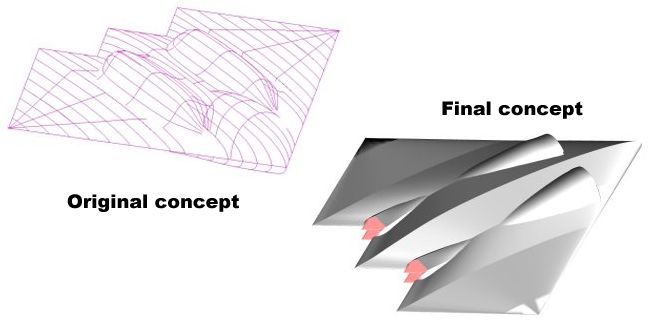|
||||||||||
|
|
||||||||||
|
||||||||||
|
|
||||||||||
|
|
|
||||||||||||||||||||||||||||||||||||||||||||||||||||||||||||||||||||||||||||||||
|
External Configuration:The three major design drivers in the external configuration of the Storm Shadow proved to be the payload, small size, and stealth requirements called for in the RFP. Four initial planforms were initially selected primarily because of their natural stealthiness--a pure flying wing, a delta wing, an X-36 derivative with canards, and an aero-diamond (see below).

Initial shapes studied by design teamSince the payload constitutes nearly 20% of the gross takeoff weight (GTOW), its center of gravity (CG) has a tremendous effect on the CG of the entire aircraft. As a result, the team concentrated on configurations that would place the CG of the bomb coincident with that of the aircraft. Thus, the release of the bomb would have little effect on the stability of the aircraft. This eliminated the delta wing and X-36 concepts since the wings are placed so far aft that the bomb must be located far forward to compensate. The flying wing was also eliminated because its large wingspan and length (dictated by the length of the bomb) made it difficult to fit eight in a C-5 Galaxy transport aircraft. An aero-diamond, defined as a planform on which the leading edge and opposite trailing edge are parallel, was finally selected because its shape is well-suited to the RFP requirements.

Aero-diamond external configuration of the Storm ShadowA second major design decision involved the choice of powerplant. It was originally hoped that one engine could be used to reduce the weight, cost, and complexity of the aircraft. However, the placement of one engine over the bomb bay would make the aircraft too thick at its center. Instead, the team chose to use two engines that straddle the bomb bay. This placement has the advantage of reducing the aircraft thickness, but forces an increase in wingspan to maintain the same wing area. In addition, there is an associated weight penalty from the added engine and structural weights.

Evolution of the Storm ShadowThe dimensions of the Storm Shadow shown below were finally determined by a combination of bomb bay size, engine size, aerodynamics, aero-diamond geometry, low observability, and center of gravity considerations.
Storm Shadow Statistics
Internal Configuration:

Internal configuration of the Storm Shadow
Internal Configuration Legend
An internal cut-away of the Storm Shadow is shown above. Clearly, the internal configuration is dominated by the bomb bay, two engines, and three fuel tanks. These items were placed to maintain a stable CG during most flight conditions (see Weight & Balance). The aircraft structure is composed of three wing spars and six fuselage bulkheads designed to withstand aerodynamic loading and to support items such as the engines and landing gear (see Structures). Stealth Design:As already mentioned, stealth was a critical driver in the overall design of the aircraft. The three types of stealth most important to the mission specifications are radar cross-section (RCS), infrared signature (IRS), and the aural (or noise) signature. The aero-diamond was chosen in part because its wing planform is considered to be an optimum low-observable shape. Horizontal and vertical tails were also removed in order to reduce the RCS and provide greater "natural" stealth. Two key methods of reducing RCS are to minimize the number of directions with high RCS returns and to maximize the scattering of radar waves in all other directions. This is accomplished using smooth curves rather than flat surfaces at right angles. The trailing edge has been saw-toothed such that the edges are parallel to the wing leading edges. This principal was also used in designing the bomb bay and gear doors to reduce edge diffraction, as is done on the Lockheed Martin F-117 Nighthawk stealth fighter and the Northrop B-2 Spirit stealth bomber. Another impact of stealth issues on the aircraft configuration was engine placement and inlet design. Jet engine fan blades are highly radar reflective, so it was decided to bury the engines within the fuselage and S-duct the inlets to hide the blades from outside radar sources. The use of buried engines also reduces the IRS and aural signature of the powerplant. Due to the relatively long ducting connecting the engines to the vectoring nozzles, the exhaust has more time to cool, further reducing the IRS. The use of a high-bypass turbofan also aids in this effort. The nozzles are also effectively buried in the saw-tooths, again lowering the IRS from every angle but directly behind the aircraft. The external skin of Storm Shadow also aids in increasing low observability characteristics. The graphite/epoxy skin absorbs a percentage of incident radar waves and heat to reduce the RCS and IRS. It is also assumed that at least part of the 500 lb allowance for classified treatments specified in the RFP will include radar absorbant materials (RAM) which will further reduce the amount of radar reflected. The airfoils selected for the Storm Shadow also play a role in increasing the stealthiness of the aircraft. Due to their behavior at transonic speeds (about Mach 0.6 to 1.3), no shocks should form on the airfoils since the flow remains subsonic up to approximately Mach 0.95, which is below the maximum speed of the aircraft. This choice not only reduces the noise signature by eliminating the possibility of sonic booms, but also helps to reduce the IRS since there is no temperature gradient across the shock. In summation, the aero-diamond configuration of the Storm Shadow was selected because of its superb stealth characteristics and excellent suitablility to the needs presented by the RFP. The design team has carefully tailored the aircraft to optimize its aerodynamic and performance capabilities while maintaining the low observability necessary to its survival. |
||||||||||||||||||||||||||||||||||||||||||||||||||||||||||||||||||||||||||||||||


|
Aircraft | Design | Ask Us | Shop | Search |

|
|
| About Us | Contact Us | Copyright © 1997- | |||
|
|
|||